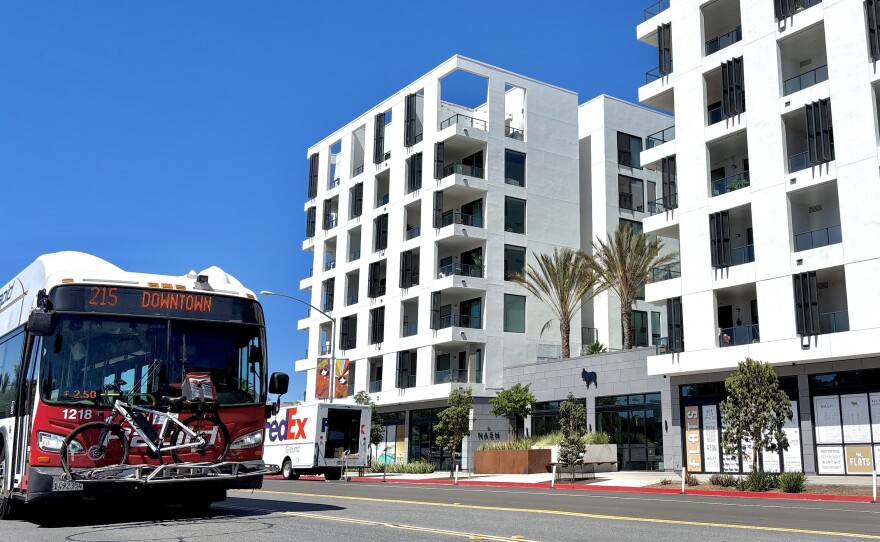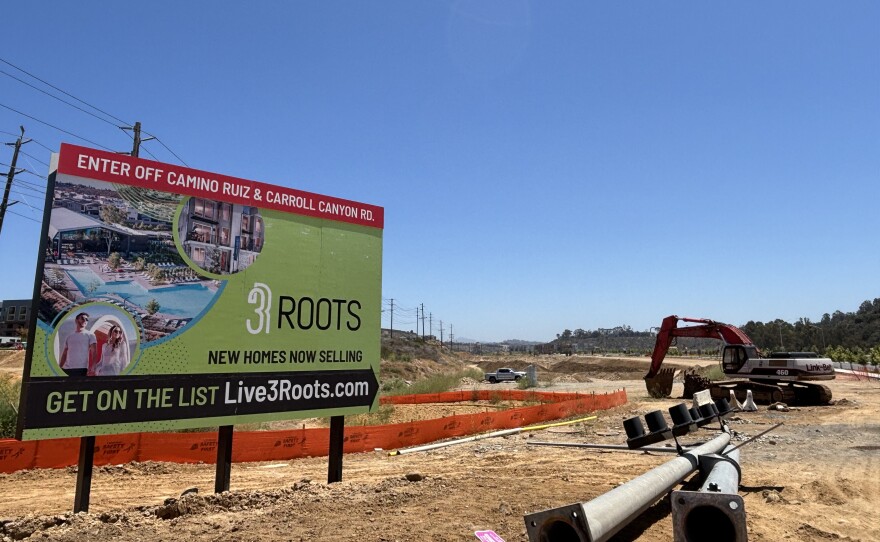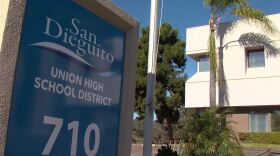San Diego's push to accelerate homebuilding in walkable neighborhoods is starting to show results, according to a KPBS and Voice of San Diego analysis of housing permit data from 2018 to 2024.
The data, visualized on the below map, reveals a high concentration of growth in the city's most urbanized communities of downtown, Bankers Hill, Hillcrest and North Park. Those neighborhoods permitted roughly 30% of the city's homes over those six years, despite making up less than 3% of its total land area.
Neighborhoods such as Mission Valley, Grantville and Kearny Mesa also saw large spikes in residential development. Coastal neighborhoods such as Point Loma, Ocean Beach, Pacific Beach and La Jolla produced just a small fraction of the city's new housing.
City Councilmember Kent Lee, who chairs the council's Land Use and Housing Committee, said the data illustrate how even the most densely populated neighborhoods still have room to grow.
"Downtown, as built out as it might look, you drive around and you can still find (on) almost every other block, empty plots of land," Lee said. "I think it's about choices and how we utilize the space that we've got."
The growth in North Park follows the city's 2016 update to the North Park Community Plan, which rezoned much of the neighborhood for higher density housing. The city has also changed its parking requirements and adopted programs that allow more density and taller buildings in exchange for affordable housing.
Among the residents who have benefited from North Park's building boom is Todd Goodall, who grew up in the suburbs of Cincinnati and moved to San Diego with his wife in 2023.
The pair, who both work remote jobs, settled in San Diego after trying out multiple cities in the United States and abroad. Goodall said they were only interested in walkable neighborhoods with a vibrant urban culture, and were drawn to San Diego's weather and pace of living.
"Places like LA and New York are much more career-driven and career-focused, people are always talking about what they do for work, and that's where they get their identity from," Goodall said. "I feel like here people are much more defined by their hobbies, what they do outside of work, and we love that as well."
Goodall and his wife rent a one-bedroom apartment in The Nash, a 190-unit building on Park Boulevard that was permitted in 2022. Goodall said they preferred a newer building after his wife experienced health issues from mold in a prior home. While their apartment isn't very big, it has a nice outdoor patio. The building also has a coworking space on the ground floor and a pool that the couple enjoys on hot days.
"We could get more space for our money than we do at The Nash," Goodall said. "But the other things about the building we love."
Several other large apartment complexes have also gone up recently nearby, though Goodall has noticed how the growth is not evenly distributed throughout the neighborhood. Most of the construction is happening on major streets.
"If you drive down El Cajon Boulevard, it feels like everything's a five-story, newer apartment building," Goodall said. "But if you get west of here into University Heights a little bit, it's still mostly single-family homes."

Goodall is happy with his housing situation today. But as he and his wife consider having kids, the only family-sized housing options they see in North Park are out of their price range. And the vast majority of new apartments in the neighborhood are studios and one-bedrooms.
"We don't need a ton of space, we don't need a massive yard," Goodall said. "In an ideal world, there would be lots of options at that two- to three-bedroom size that weren't just single-family homes built in the 70s that need work."
The data, which was reported by the city to the California Housing and Community Development Department, also show how the vast majority of new housing in San Diego is apartments. Buildings with five or more units made up about 74% of San Diego's new housing between 2018 and 2024. Single-family homes made up only 6% of new homes.
Accessory dwelling units, which can be built in the backyard of a single-family home, made up about 16% of all housing permits. However, ADUs are the only type of housing that San Diego builds in significant numbers within single-family neighborhoods. Those neighborhoods still make up the vast majority of the city's residential land.
Councilmember Lee lives in Mira Mesa, where the 1,800-unit development of 3Roots is nearing completion. He previously served on the Mira Mesa Community Planning Group and recalls opponents to the project saying it would put more strain on the neighborhood's infrastructure.
He said they wanted better roads, parks, libraries and public transit to be built first.

“At the same time, we don't plan for those things because we don't think we have enough people in the area to utilize them,” Lee said. “People always get into this argument of, why don't we have one first before the other? And the true answer is … we need to plan for both, and both at the same time.”
But instead of straining the neighborhood’s infrastructure, Lee said the opposite has happened.
In 2005, city officials announced plans to upgrade the Mira Mesa Recreation Center with a new pool, skate park, playground and other amenities. The project sat unfunded for 18 years, Lee said, until the builders of 3Roots secured their permits and paid their fees to the city. Those fees are what allowed the rec center upgrades to finally move forward, Lee said.
The new residents in 3Roots also pay the sales taxes, property taxes and water and sewer bills that help fund city infrastructure and services, Lee added.
"I think a lot of people look at housing and they think of it as a burden," Lee said. "And I just think the complete opposite. I get the strong sense that housing is nothing but an opportunity."






